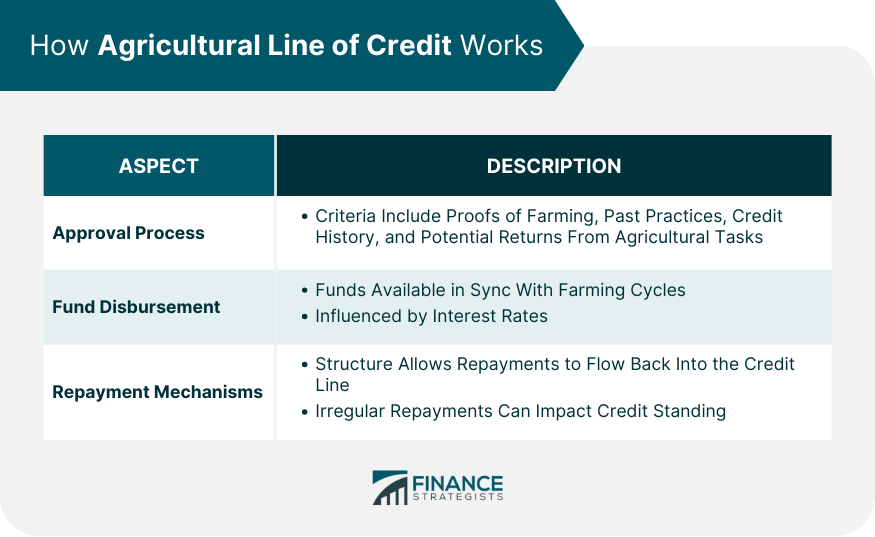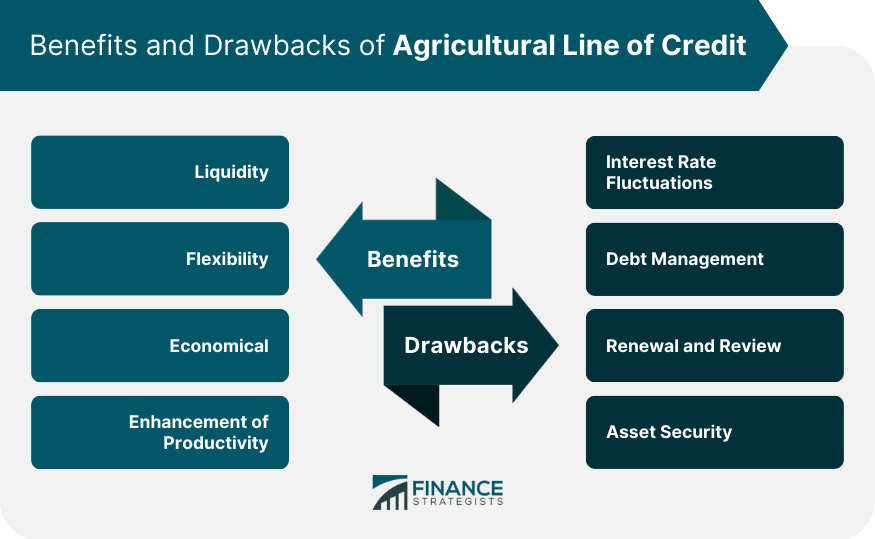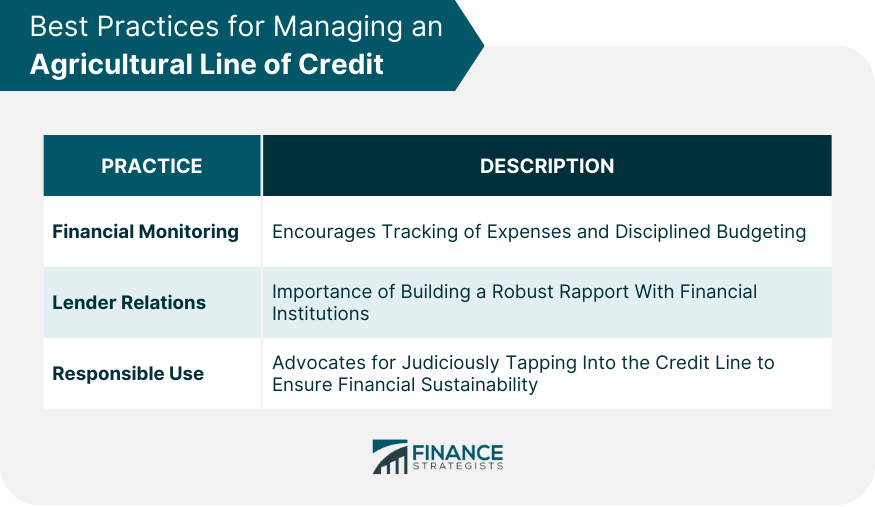In the realm of agriculture, timely access to funds can make the difference between a bountiful harvest and missed opportunities. The Agricultural Line of Credit, or ALoC, emerges as a beacon of hope. This mechanism offers a revolving credit facility from financial institutions. Rather than a lump sum, farmers can draw upon this credit line as needed, up to a certain limit. This tailor-made solution addresses the specific cash flow demands of farming, adjusting to the ebbs and flows of planting and harvest seasons. This credit line's purpose goes beyond mere financial support. Agriculture, with its myriad uncertainties—be it unpredictable weather or market dynamics—demands a robust safety net. The ALoC provides this, ensuring that essential operations, like purchasing seeds or equipment repairs, don't stall due to lack of funds. In essence, this credit facility forms the backbone of consistent farming operations, allowing agricultural endeavors to thrive even in the face of unforeseen challenges. Diving into the Approval Procesvs, one finds it methodically structured. To safeguard the system's integrity, financial institutions have clear criteria. Proofs of active farming, land-related documents, and a review of past farming practices often come into play. Additionally, to assess the risk, institutions might delve into the farmer's credit history and the potential returns from the proposed agricultural activities. Fund Disbursement differs from traditional loan systems. Think of it as a reservoir of funds that farmers can tap into during specific periods, usually in sync with farming cycles. The interest rates, whether fixed or variable, hinge on several factors. These could range from broader market dynamics to the specific profile and needs of the farmer in question. Repayment stands as a pivotal aspect of the Repayment Mechanisms. The structure here offers a blend of discipline and flexibility. Repayments can flow back into the credit line, allowing for subsequent redraws. While this structure aligns with income cycles of agriculture, notably harvest seasons, there's a catch. Irregular repayments can dent a farmer's credit standing, possibly making future financial endeavors more challenging. With the liquidity provided by the ALoC, farmers find themselves better equipped to handle the unpredictable nature of agriculture. Quick access to funds ensures they can swiftly address immediate needs. Whether it's an unforeseen pest invasion necessitating urgent intervention or an equipment malfunction during critical farming stages, having funds on standby can be a game-changer. The flexibility in the ALoC system is a notable merit. Rather than being saddled with interest on a large lump sum, farmers enjoy the liberty to borrow as the situation demands. This setup not only curtails interest costs but also fosters prudent financial management, urging farmers to borrow only when absolutely necessary. From a broader perspective, the ALoC system emerges as a more economical option. Often, the interest rates here are more competitive than those of traditional agricultural loans. Add to this the flexibility of borrowing, and farmers often find that their overall financial burden diminishes over time. Plus, the adaptability of this credit line means it can accommodate a wide spectrum of agricultural needs, from livestock purchases to infrastructure enhancements. In terms of productivity, the ALoC acts as a catalyst. By facilitating the enhancement of productivity, it ensures that farmers aren’t hamstrung by financial constraints. The ability to make timely investments, be it in high-yield seeds or advanced farming equipment, directly impacts the quality and quantity of produce. However, the path isn't devoid of hurdles. For instance, interest rate fluctuations can pose challenges. If tethered to a variable interest rate, the ALoC might expose farmers to fluctuating financial commitments. This unpredictability can, at times, make budgeting a complex task. While ALoC offers a financial reservoir, it's essential that farmers navigate it judiciously, considering debt management. The convenience of drawing funds can sometimes lead to over-reliance, which in turn might spiral into unmanageable debt levels if unchecked. Furthermore, the renewal and review protocol might seem daunting to some. Unlike a one-time loan approval, the ALoC demands periodic reassessments. These reviews scrutinize a farmer's financial health, the viability of ongoing agricultural operations, and the repayment track record. This recurring assessment could potentially sway the stability of the credit line’s availability. Additionally, Asset Security stands as a double-edged sword. While assets like land or machinery can secure the credit line, they also stand at risk. In scenarios where repayment falters, these assets might be confiscated, endangering the very foundation of a farmer's livelihood. To maximize the potential of ALoC, it’s essential to incorporate financial monitoring. A vigilant eye on expenses, combined with disciplined budgeting, can prevent financial missteps. Anticipating future financial requirements, especially during peak agricultural phases, can streamline borrowing decisions. Maintaining a robust rapport with financial institutions is paramount. Good lender relations can open doors to more favorable terms or even guidance during challenging times. Regular interactions, keeping lenders in the loop about farming ventures, and actively seeking advice can lead to a more harmonious and beneficial relationship. Lastly, emphasizing responsible use ensures the longevity of the credit line. The ALoC, with its vast reservoir of funds, should be tapped judiciously. Prioritizing essential expenditures and adhering to planned budgets can safeguard against potential financial pitfalls. The Agricultural Line of Credit (ALoC) serves as a beacon for farmers, ensuring sustained operations even amidst uncertainties. It offers unmatched liquidity, enabling timely interventions in the farming process, while its inherent flexibility means farmers only borrow as needed, curbing unnecessary interest costs. However, like all financial tools, it comes with its challenges. Interest rate fluctuations and the potential pitfalls of debt management underscore the need for judicious use. Moreover, the continuous review process emphasizes the importance of maintaining a healthy financial profile. As agricultural landscapes shift and new challenges emerge, the ALoC stands as an essential tool, fostering resilience and paving the way for a prosperous farming future.What Is An Agricultural Line of Credit?
How Agricultural Line of Credit Works
Approval Process
Fund Disbursement
Repayment Mechanisms

Benefits of Agricultural Line of Credit
Liquidity
Flexibility
Economical
Productivity
Drawbacks of Agricultural Line of Credit
Interest Rate Fluctuations
Debt Management
Renewal and Review
Asset Security

Best Practices for Managing an Agricultural Line of Credit
Financial Monitoring
Good Lender Relations
Responsible Use

Final Thoughts
Agricultural Line of Credit FAQs
Agricultural Line of Credit (ALoC) is a financial instrument offered by institutions, providing farmers with a revolving credit facility. It allows them to borrow funds as needed, up to a set limit, to support their farming operations.
Unlike traditional loans that provide a lump sum, an Agricultural Line of Credit offers flexibility, allowing farmers to draw funds as required, often aligning with farming cycles. Interest is typically charged only on the amount drawn, not the entire credit line.
Agricultural Line of Credit ensures consistent cash flow, enabling farmers to meet unexpected expenses, purchase inputs, or invest in equipment, thereby addressing the unpredictable nature of farming.
Yes, potential risks with an Agricultural Line of Credit include fluctuating interest rates, challenges in debt management, and the possibility of assets (like land or machinery) being confiscated if repayments aren't met.
Farmers can apply for an Agricultural Line of Credit through financial institutions offering this service. The approval process usually involves assessing the farmer's credit history, farming practices, and potential returns from the proposed agricultural activities.
True Tamplin is a published author, public speaker, CEO of UpDigital, and founder of Finance Strategists.
True is a Certified Educator in Personal Finance (CEPF®), author of The Handy Financial Ratios Guide, a member of the Society for Advancing Business Editing and Writing, contributes to his financial education site, Finance Strategists, and has spoken to various financial communities such as the CFA Institute, as well as university students like his Alma mater, Biola University, where he received a bachelor of science in business and data analytics.
To learn more about True, visit his personal website or view his author profiles on Amazon, Nasdaq and Forbes.











